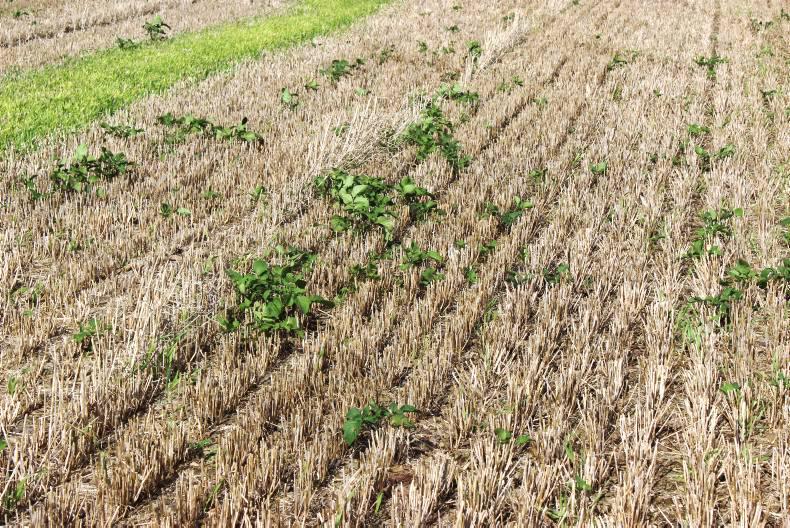Price pressure and bad weather may have altered many plans on tillage farms this spring. Last week, I spoke about the need to seriously question planting this spring, especially cereals that appear not to be wanted based on the price signal from the market.
In that article, I mentioned that one might consider spring oilseed rape – a potentially low-cost crop that is not yet late, but it would need to be shown this week.
I mention this again because some believe that there is potential for upside on price for this crop for the coming harvest. And apart from seed and fertiliser, a single insecticide could get you out on clean land, so it could help cashflow.
Fallow considerations
But what if you decide to leave the land idle – are there other implications for things such as greening? The answer is yes, but they generally work in your favour. Fallow is regarded as a land use or crop in itself, just like new grass (< five years). So, for the two- or three-crop rule, it can help fulfil that obligation. But it can do more.
Fallow can also be used to fulfil the ecological focus area (EFA) requirement, providing it is declared as fallow-greening.
But certain other constraints then apply, such as the fact that this area cannot be planted in the January to 31 July period.
So, if you were depending on getting a protein crop planted that is not yet sown (and it is now too late for beans), fallow can provide an alternative. If you have 100 acres and you opt to leave 10 acres in fallow, that’s 10% EFA just from the fallow, without counting in the contribution from landscape features.
If a farmer wants to plant a cover crop, this should be declare as mixed crops. However, this will not contribute to EFA.
I understand that many farmers are seriously considering the option of not planting cereals this spring and, in some instances, that might extend to a number of hundred acres. However, a bigger proportion are likely to look at fallowing their poorer land, which normally drags down average yield.
This could be even more useful for smaller-scale growers who are caught on the thresholds of area for either the two- or three-crop diversification requirement.
It is important to remember that fallow is still part of the arable area and so cannot be used to pull you below any of the crop diversification thresholds.
Fallow is also considered to be part of the grassland area on a farm and so may push some growers over the 75% threshold, which could mean no greening obligation.
It also counts as a crop in itself and so can be used to draw down payments under the Basic Payment Scheme on those hectares.
Alternative uses
Where fallow does not provide some of these marginal benefits, growers might consider other options. The simple one is to grow a different crop such as spring oilseed rape. But it will quickly become late for that too if planting cannot take place shortly. So what else can one do?
Given the way this spring is progressing, the first question must relate to fodder. Are there neighbouring livestock farmers who are now interested in having additional fodder produced for them?
Maize is an immediate thought, but it depends on where you are and the nature of local livestock enterprises. Maize presents its own risks too, because you depend on that customer to actually take the crop from you.
If we get a lot of grass growth later in the year, it is not impossible that your customer may call to say that your crop is no longer needed. Where do you go then?
A second fodder crop option is fodder beet. But you need to have a level of expertise and the necessary equipment to handle this crop. And you really need fertile land.
There are additional challenges at feeding time, such as cleaning and chopping. Fodder beet is an attractive crop, but you depend on a customer to actually take the crop.
Grass is another fodder option that is worth considering. It provides more flexibility for use (if someone wants it) and can be left down for a second year, providing a useful rest for the ground.
Grass is still a great option in tillage rotations and if you use grass in conjunction with an individual livestock producer, you may get some additional organic matter on to the land.
A few tillage farmers already work in co-operation with livestock farmers to help provide a structured reseeding approach through the sharing of land.
The resurgence of catch crops is also something that can be considered on fallow land.
There is no doubt that the growing of catch crops is good for the land, but it is more difficult to prove benefit to the following crop.
Having something growing in the ground is better than nothing, but it should not end up as a net cost, which barley could do today.
An inbetweener
One of the major issues regarding the sale of crops between farmers is the security of demand, quality and payment.
These issues must be fairly assessed and handled, and one wonders if this process can be adjudicated by co-ops or merchants who have members/customers on both sides of this equation.
Yield must be fairly assessed and quality must be valued. If deals between farmers are not win-win, they will not be repeated.
These arrangements need to be promoted. It is far safer for merchants to promote the production and sale of crops between farmers at values that make sense than to have land sitting idle and that is the alternative.






 This is a subscriber-only article
This is a subscriber-only article











SHARING OPTIONS: